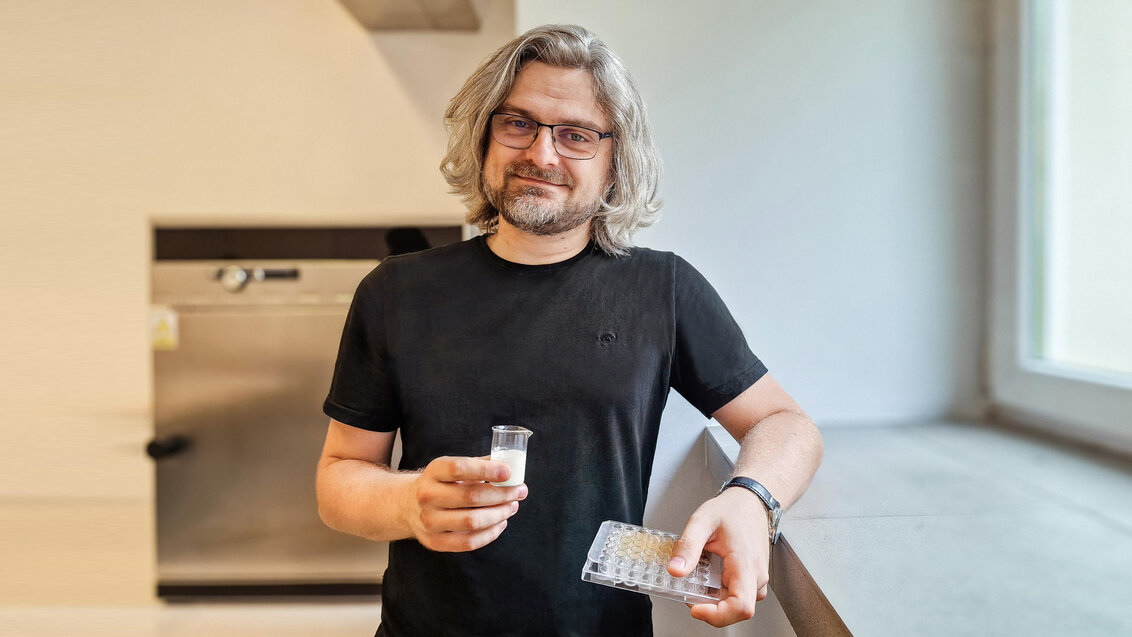
Piotr Szatkowski, AGH University: Biomaterials based on natural substances may improve efficiency and comfort of patient treatment. Photo by Marianna Cielecka
Treating hard-to-heal wounds constitutes a serious challenge for modern medicine. Such wounds are not only painful and troublesome for patients, but may also lead to severe complications, such as infections, amputations, and even death. Carried out by researchers from the AGH University of Krakow together with teams from the Jagiellonian University, University of Agriculture in Krakow, and University of British Columbia in Canada, the project is aimed at developing a novel hydrogel dressing containing natural constituents from sheep and camel milk. The dressing shall be antibacterial, anti-inflammatory, stimulate the regeneration of tissues, which will accelerate the healing process and reduce the risk of complications.
The manager of the international and interdisciplinary research team is Dr Piotr Szatkowski from the Department of Biomaterials and Composites at the AGH University Faculty of Materials Science and Ceramics. Within INNOGLOBO III project of the National Centre for Research and Development, the scientists have been developing and preparing for patenting the hydrogel dressing for hard-to-heal wounds containing natural constituents derived from sheep and camel milk. The total of funding for the project is over PLN 1.5 million, and its implementation shall take up to three years.
Properties of nature-based materials
The natural products rich in bioactive substances which support skin’s regenerative processes and wound healing are sheep and camel milk. In comparison to cow’s milk, both of these products contain high levels of insulin which is particularly relevant in wound healing. Insulin regulates the level of glucose in blood and may support the treatment of damaged skin by regulating inflammatory reactions and stimulating cell migration. Previous studies indicate that local administration of insulin has a significant effect on the healing of diabetic and chronic wounds as well as burns.
In the age of civilisational illnesses, developing a hydrogel dressing material enriched in active substances may help in treating, for example, diabetic wounds. Developed by the team of experts, the dressing could be an important factor in the treatment of this type of conditions due to its rich content of bioactive substances, including insulin, lactoferrin, orotic acid, or conjugated linolenic acid. These substances are significantly valuable in the healing processes owing to their numerous positive properties such as anti-inflammatory effects and stimulation of cell growth and migration.
“We think that the sheep and camel milk will be the element of the dressing that has the healing potential and will contribute to the regeneration of skin cells. The biomaterials we have developed may significantly improve the efficiency and comfort in treating patients with skin problems, especially diabetics,” Dr Szatkowski explained.
A vital part of the task will be to conduct detailed cellular and molecular studies to determine the bioactivity of the dressing being developed.
The project assumes the development of a hydrogel dressing based on sheep and camel milk. Photograph: AGH University

How is such a camel milk hydrogel dressing made?
“The camel milk will come from a dairy farm in Poland that breeds camels,” Dr Szatkowski specified.
First of all, the milk shall be lyophilised in -80 °C, which will keep the active substances from breaking down, maintaining their original form.
“It’s a key stage. It’s important for the milk not to lose its valuable properties in thermal processing,” Dr Szatkowski said.
Lyophilised milk is going to be the carrier of bioactive substances in hydrogel dressings consisting of three layers, as depending on the position of the layer relative to the wound, the amount of the milk liophilisate is going to be different.
In the first research task, the researchers will develop hydrogel multilayer dressing material containing bioactive substances.
Of utmost importance will be to develop the best hydrogel matrix for the dressing. Moreover, we have to determine the minimum content of the so-called functional additives in the dressing, physicochemical properties of the material, how much longer we may use such a dressing in comparison to a regular one, and so on.
Then, the researchers will perform a number of screen tests to biologically evaluate the dressing functionalised with active substances from sheep and camel milk. Another stage of tests includes cellular analyses aimed to check whether the dressing has some effect on the cell viability and the wound’s confluency rate.
Interdisciplinary cooperation
The research team that has decided to undertake the ambitious task of developing innovative dressings comprises of experts on materials engineering, research on animal-based materials, physiology, and biomedical research. The role of the AGH University team is, above all, to develop the matrix for the hydrogel dressing and perform physicochemical tests. Material engineers will have to deal with the structure of the dressing itself, as well as with the optimisation of its composition, and finally with its production. Professor Anna Ptak from the Jagiellonian University together with Dr Edyta Molik and Dr Aneta Koronowicz from the University of Agriculture will study the milk’s bioactive substances and carry out in vitro cellular tests of the hydrogel dressing. Foreign consortium members, i.e. academics from the University in Canada, will perform specialised molecular research to determine the biological activity of the dressing. Subsequently, the team will apply for a patent for the novel dressing.
 Projects by AGH University Main Library with funding from Scientific Social Responsibility programme
Projects by AGH University Main Library with funding from Scientific Social Responsibility programme  On energy transformation and more. Distributed Energy Congress
On energy transformation and more. Distributed Energy Congress  Polish natural hydrogen initiative. AGH University concludes an agreement
Polish natural hydrogen initiative. AGH University concludes an agreement  Honouring those we lost this year
Honouring those we lost this year  AGH Solar Boat the best in Sardinian competition
AGH Solar Boat the best in Sardinian competition  AGH University Alumni Day 2024
AGH University Alumni Day 2024  AGH University to establish AI Factory
AGH University to establish AI Factory 

